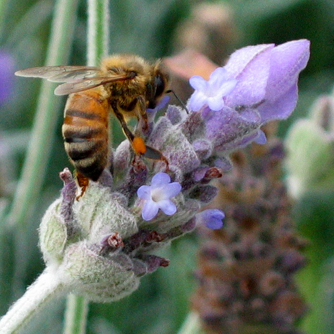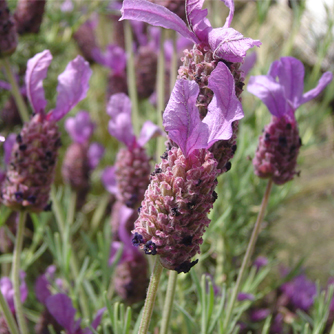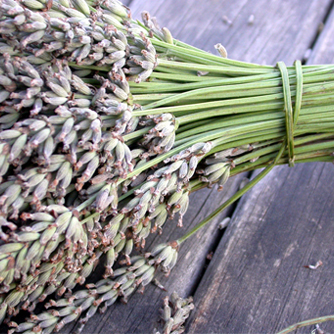Lavender
BackLavender was said to ward off evils spirits in olden times but these days you’re more likely to find it used in perfumes, hand lotions and other cosmetics. It’s a lovely fragrant herb that can also combat headaches, tension, exhaustion and aid digestion. Lavender is a quick growing, hardy perennial shrub which is a great addition to any garden, providing wonderful fragrance, abundant flowers and a great contrast with its silvery grey foliage.
One quirky feature of lavender is their square stems which is typical of plants in the Lamiaceae family. Grow it as an informal hedge, in large pots or as specimen plants in garden beds and near the veggie patch to attract bees.
Types of Lavender
There are just over 30 different species of lavender and many more cultivars in a range of sizes and flower colours. Below are the three mostly commonly grown types:

French lavender in flower
English lavender (Lavandula angustifolia)
English lavender has a narrow leaf and produces summer flowers on long stems that attract bees and butterflies. It’s a great choice for hot, dry rockeries with poor soil once established. It can also withstand very cold temperatures. English lavender is typically used for pot pourri and essential oil production. Colours range from pink, purple and white.
Italian lavender (Lavandula stoechas)
Italian lavender grows wild in the countryside of France, Spain and Italy and has short stemmed flowers with long ‘bunny ears’ bracts on top. To make things confusing it can also be called Spanish or French lavender. Either way it’s a heavy bloomer with flowers from late winter into summer. Colours range from purple, pink white and a cream form. Look for some of the good performing dwarf varieties suitable for more humid conditions in the ‘Bee’ and ‘Bella’ range.
French lavender (Lavandula dentata)
French lavender is the most commonly grown species in Australia with lovely silvery, serrated leaves and soft mauve flowers. Main flowering occurs in winter and early spring but it often has flowers all year, French lavender is a vigorous lavender growing to 1.5m x 1.5m but there is also a dwarf form available.

Bees adore lavender blooms
How To Grow Lavender
Being of Mediterranean origin, lavender likes hot, dry summers and cold wet winters. This is perfect for most of inland Australia and dry coastal areas but can be problematic in humid coastal zones and tropical regions. In these wetter areas consider treating lavenders as annuals or short-lived perennials as they’ll eventually succumb to some kind of fungal rot.
Full sun and good drainage are essential for success with lavender. Heavy clay soils are out (or need to be greatly improved with gypsum) and so are very acidic soils. Lavenders thrive on soils which are rich in calcium. Regular applications of dolomite or lime will easily address this need.
Take care with mulching as it may hold too much moisture around the base of the plant and increase rot problems especially in wetter regions. Leave 5-10cm space between the mulch and the main stem.
Established lavenders don’t require much fertilising but new plants will benefit from regular applications of OCP eco-seaweed and OCP eco-aminogro to help settle them in and promote growth.

Italian lavender with distinct "bunny ears" flower heads
Pruning and Propagating Lavender
Give plants a light prune all over after their main flowering finishes to keep plants tidy and dense. Timing will vary according to the variety you are growing. Harder pruning can be done if required (by about a third) but avoid cutting into older bare wood as branches don’t always recover.
Lavender can be easily propagated from hardwood cuttings taken in autumn and winter.
Pests and Disease of Lavender
When grown in ideal conditions (full sun, free-draining calcium rich soil and low summer humidity) they are generally trouble free. In conditions other than this fungal problems usually appear. Commonly it will be root rot and death of lower foliage making bushes look very scraggy. These fungal problems will be more apparent in older, less vigorous plants.
Regular applications of OCP eco-seaweed may help stave off fungal problems. Ultimately though you should aim to improve the growing conditions or replace older plants with younger plants periodically.
Lavenders are seldom attacked by pests however whitefly and aphids can sometimes be a problem. Treat with a couple of sprays of OCP eco-oil for easy control. If scale appears then treat with a horticultural oil.

English lavender bunch ready for drying


